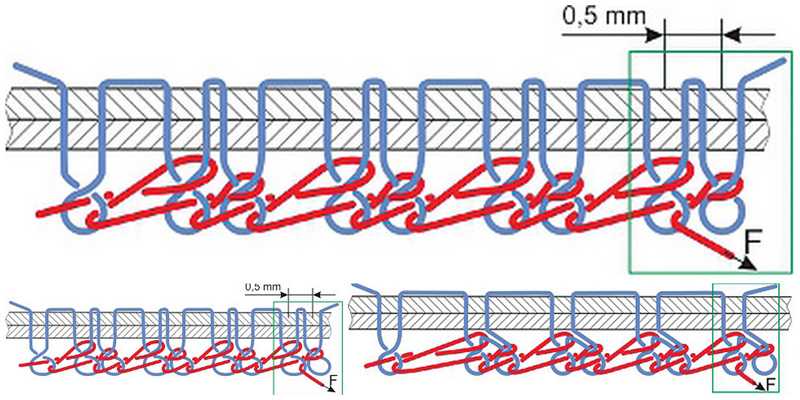Double thread chainstitch (type 401) is the second most popular stitch type used in apparel sewing for joining two plies of fabric. Although double thread chainstitch has several advantages over the lockstitch (type 301), like no stoppage to change bobbin thread and less puckering in densely woven fabrics, it is still having the tag of being insecure due to unravelling. In case of any skip stitch or stitch break during garment use, double thread chainstitch becomes vulnerable to stitches falling apart. All double thread chainstitch seam ends are secured either by bartack or enclosed crossover seams. A new modified ‘ZARIF’ double thread chainstitch offers innovative features and promising uses in apparel manufacturing. Dr. Prabir Jana, NIFT Delhi analyses the technology…


World’s first application of a rotating thread looper created the new double thread chainstitch type 401, where the loop of the top thread and the loop of the bottom thread are rotated by 180 degrees. And now the new modified form of 401 type of chainstitch is here – ZARIF double thread chainstitch technology, named after its inventor Dr. Zarif Sharifovich Tadjibaev, Director of ZARIF Sewing Machine Co. from Tashkent of Republic Uzbekistan. The astonishing claims of the new ZARIF double thread chainstitch technology can safely be called the ‘industrial revolution’ in sewing.

How is the ZARIF double thread chainstitch different?
ZARIF double thread chainstitch uses needle with one long groove, rotating looper, pusher of the bottom thread, and works with drop feed mechanism. The machine uses rotating disc type take-up mechanism for both top and bottom threads. Of the six working units (needle, looper, pusher of the bottom thread, top thread take-up, bottom thread take-up, and feed dog), the three working units (looper, top thread take-up, and bottom thread take-up) make a rotational movement.
If we look at the lockstitch, the lock is formed at the middle of the ply, thus displacing fabric yarns and prone to cause puckering due to structural jamming. Whereas the chain is formed at the backside of the ply for both the double chainstitch and ZARIF double thread chainstitch, decreasing the possibility of puckering due to structural jamming. The difference between normal double chainstitch and ZARIF double thread chainstitch is the interloop formation. In normal double chainstitch, the loop of the top thread as well as bottom thread is straight, whereas in ZARIF double thread chainstitch loop of the top thread and the loop of the bottom thread are rotated by 180 degrees. This difference in the stitch structure has resulted in numerous benefits as claimed by ZARIF.
What does ZARIF double thread chainstitch claim to offer?
ZARIF sewing machine is capable of sewing different materials (textiles, leather, and knitwear) with a thickness of 8 mm at a needle bar stroke of 32 mm, and without adjustment of the thread’s tension. It is capable of tight and very tight sewing of different materials by using double thread chainstitch. It is possible to achieve very tight sewing of materials by increasing only the tension of the top thread. A very smooth seam on light material and elastic seams on elastic materials is possible just by changing the setting from normal chain seam to the elastic chain seam.
The ZARIF double thread chainstitch sewing machine for the first time used the needle with one long groove (same as the needle used in lockstitch sewing machines) to make a double thread chainstitch. This is a remarkable achievement, simplifying inventory management of needles in factories. Also, needle size of Nm.130/21 can be easily replaced by Nm.60/8, without carrying out adjustment of looper concerning a needle, as the maximum allowable clearance between point of looper and needle is 0.5 mm. This offers tremendous flexibility and reduced workload to machine engineers during style changeover.
ZARIF sewing machine offers three variants of ZARIF double thread chainstitch created for specific characteristics. It is possible to get a special non-ravelling high breaking strength and highly elastic double thread chain seams using the electronic control of the feed materials (same as Brother S-7300A, Nexio).
Future possibilities
The new ‘ZARIF’ double thread chainstitch technology promises to surpass the universality of sewing various materials of all existing sewing technology. It may significantly expand the area of application of the double thread chainstitch, by replacing lockstitch. As is known, replacement of lockstitch on the double thread chainstitch leads not only to increase in productivity due to no need of bobbin thread change but will also increase the seam strength. The ZARIF double thread chainstitch technology may become the universal stitch type for all automated sewing systems where generally double chainstitch (401) is preferred over lockstitch (301).
Although the technology was patented (No.PCT/UZ1995/00001) way back in 1997 (US6095069 patent granted on 2000), no commercial model of ZARIF double thread chainstitch is currently available for sale, the inventor is inviting cooperation from interested sewing machine manufacturers to jointly commercialise the invention. This might be a golden opportunity for established sewing machine manufacturers to grab the most promising sewing technology that is going to be the de facto standard in future.

Post a Comment